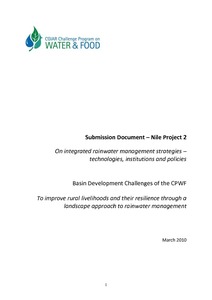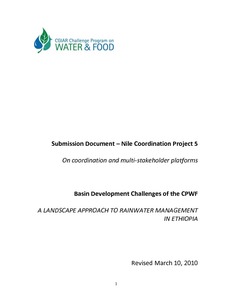Payments for biodiversity conservation in the Masai Mara: what impacts on pastoral livelihoods?
Vulnerability and sustainability of livelihoods in (agro) pastoral systems
Dealing with Drought: Reducing the vulnerability of agro-pastoral systems to climate change in East and West Africa
Regulations on Bayinbuluk Grassland Ecological Protection.
The purpose of these Regulations is to protect construct and rational utilize Bayanbulak grassland, prevent grassland ecological degradation, improve the grassland ecological environment and promote sustainable economic and social development.The people's government of the autonomous prefecture should integrate the protection, development and use of grasslands into national economic and social
N2: On integrated rainwater management strategies – technologies, institutions and policies
Integrated rainwater management strategies combine technologies, policies and institutions.
N4: On assessing and anticipating consequences of innovation
This project is about showing whether RMSs are effective. It will seek to quantify the consequences of improved RMS for community livelihoods, resource productivity, land quality, and downstream water quality and siltation. It will specifically measure the downstream, cross-scale consequences of successful innovation in the Ethiopian highlands.
Strengthening livelihood resilience in upper catchments of dry areas by integrated natural resources management
The Livelihood Resilience project evolved around the hypothesis that better integrated
management can improve the livelihoods of poor farming communities and increase the
environmental integrity and water productivity of upstream watersheds in dry areas. This
hypothesis was tested by researchers from different Iranian research and executive organizations
Developing Index Based Livestock Insurance for managing livestock asset risks in Northern Kenya
This study develops an index-based livestock insurance (IBLI) product for managing key livestock asset risks of pastoralists in the arid and semi-arid lands of northern Kenya, where insurance markets are effectively absent and uninsured risk exposure is a main cause of persistent poverty.
The challenge of integrated water resource management for improved rural livelihoods: Managing risk, mitigating drought and improving water productivity in the water scarce Limpopo Basin
The Challenge of Integrated Water Resource Management for Improved Rural Livelihoods:
Managing Risk, Mitigating Drought and Improving Water Productivity in the Water Scarce Limpopo
Basin: Integrated Water Resources Management (IWRM) is a systems approach to water
management, based on the principle of managing the full water cycle. It is required, not only to
N5: On coordination and multi-stakeholder platforms
Agricultural intensification of rainfed agriculture (Demeke et al, 1996)– especially of the dominant crop-livestock systems in the Blue Nile basin, management of the natural resource base and poverty alleviation have long been the targets of a vast array of research and development initiatives in the region.










